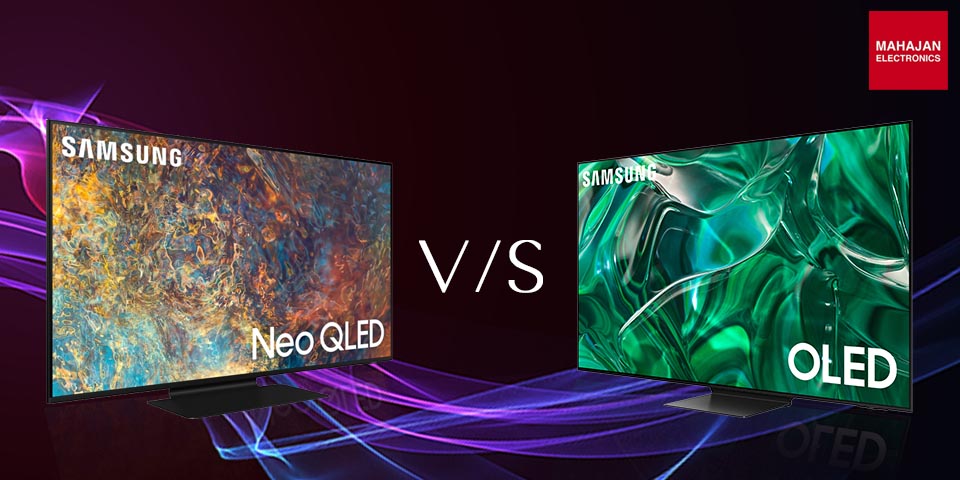Neo QLED and OLED are the two significant terms you must have heard if you recently go out to purchase a TV. But what’s the difference between these two panels, and how to make a choice?
Since both pack a punch of great features, you cannot go wrong with either choice. But remember that New QLED and OLED come with a dedicated set of pros and cons that you must be aware of before shelling out your hard-earned cash. So, without any further delay, scroll down the page and learn which panel is worth choosing.
Samsung Neo QLED Vs. OLED - The Pros and Cons to Know
Both Samsung NEO QLED and OLED feature significant improvements over previous panels. However, both offer different pros and cons. For example, Neo QLED is often considered best for gamers, while OLED is a go-to choice for enjoying the best streaming experience.
Hence, before we delve into the comparison, let’s round up the pros and cons of these panels individually to give a clear idea. Let’s have a look.
Samsung Neo QLED
|
Pros |
Cons |
|
Superior brightness |
Black levels are still below OLED TVs |
|
Impressive color gamut |
Viewing angles could have been improved. |
|
Uses mini-LED backlighting |
|
|
Up to 8K resolution |
OLED
|
Pros |
Cons |
|
Excellent contrast and black levels |
Shorter lifetime |
|
Slim models |
Features burn-in risk |
|
Impressive streaming experience |
|
|
Exceptional color reproduction |
The Key Differences Between Samsung Neo QLED and OLED
So, what makes these panels different? Since Samsung Neo QLED and OLED look incredibly similar, understanding the key differences between them isn’t always easy.
So, before you make the final commitment, make sure to learn the major differences between Samsung Neo QLED and OLED, and make your choice wisely.
Whatever option you choose, both QLED and OLED offer more stunning picture quality than those past-generation panels. However, since Neo QLED offers excellent brightness, it is ideal for brightly lit rooms. Also, QLED features a mini-LED backlight that produces superb brightness, making the setup ideal for a light and airy TV room.
On the contrary, OLEDs are the best bet for darker rooms. They have superior viewing angles, thus offering the perfect viewing experience.
Another notable factor that may help differentiate Neo QLED and OLED is Black Levels and Contrast. When it comes to Black Levels, nothing can compare to the OLED reigns, thus making it an undisputed champion.
Neo QLEDs, on the contrary, are forced to dim their LED backlights to offer the perfect contrast. And undoubtedly, that’s something hard to achieve. Also, the QLED’s efforts to dim their LEDs to attain black levels are visible, and you may notice a slight glow on dark parts. So, for now, OLEDs come out on top in terms of black levels and contrast.
While both panels offer excellent color space compared to other panels, Neo QLED has a slighter edge in this aspect owing to the Quantum Dots. The use of these dots allows QLEDs to inch forward in terms of color accuracy, volume, and brightness than OLEDs.
According to Samsung, Neo QLEDs have a wider range of better-saturated colors at extreme brightness levels, thus delivering a real advantage in normal viewing situations.
The next thing we’ll use to differentiate both panels is Response Time and Refresh Rate. Both terms go hand in hand and create a huge difference than expected. Response Time refers to the time it takes for a pixel to switch from one position to another.
The faster the response time, the more crisper the image. And speaking of QLEDs and OLEDs, the latter is much faster than the former, giving them a competitive edge. QLED response time varies between 2 and 8 milliseconds, while OLED’s response time is about 0.1 milliseconds.
Similarly, OLEDs surpass QLEDs in terms of refresh rate too. Although QLEDs are showing improvements in this aspect, we still give OLED a win, owing to its faster response time.
To Summarize
In conclusion, neither an OLED TV nor a QLED is better than the other. And the final choice boils down to your preferences. The one that’s right for you depends on several factors, including budget, viewing preference, and space. So, it’s recommended to analyze your requirements and pick the option accordingly.

